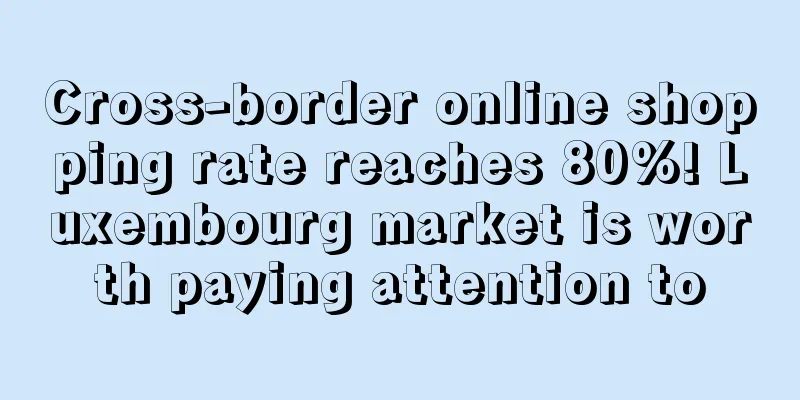Cross-border online shopping rate reaches 80%! Luxembourg market is worth paying attention to

|
Europe is another big piece of cake for cross-border e-commerce sellers, and its market size cannot be underestimated. Except for the popular UK and Germany, other countries are still performing strongly.
In 2020 , the total turnover of European cross-border e-commerce was 146 billion euros, a year-on-year increase of 35%. And according to statistics , one-quarter of Europeans' online shopping is cross-border.
Among them, Luxembourgers make the most cross-border online purchases, while the Dutch make the least . Belgium's cross-border e-commerce turnover is still growing rapidly, and the largest e-commerce market is in Germany.
Luxembourg ranks first
Luxembourg ranks first among the top 16 European cross-border e-commerce countries . An important reason is the high Internet penetration rate, with 94% of residents active online, and the proportion of cross-border online shopping reaching more than 80%. Shopping platforms are mainly concentrated on Amazon Germany and Amazon France, as well as local platforms Zalando, Asos, Veepee, and Fnac. Consumer categories are mainly clothes, shoes, and accessories.
Belgium sees strong growth
Affected by the epidemic, Belgium 's cross-border e-commerce has seen significant growth in 2020, with turnover reaching 4 billion euros, a year-on-year increase of 53%. The main shopping platforms are Zalando, Zara, H&M, Amazon, Wish and AliExpress.
Germany has the most e-commerce platforms
Germans' preferred shopping platform is Amazon, with sales reaching 13 billion euros in 2020. In addition, there are local platforms such as Otto and Zalando. The main consumption directions are electronics and media, followed by fashion.
Sweden ranked second
Benefiting from the influence of H&M, Sweden ranks second. The local online penetration rate reaches 73%. The largest e-commerce market is the fashion industry, accounting for 31% of Sweden's e-commerce revenue. The second largest market is electronic media.
Cross-border e-commerce in France is growing slowly, and local Fnac, Carrefour and La Redoute are also constantly expanding their markets. After Brexit, cross-border trade in the UK has been negatively affected to a certain extent.
From this perspective, the European e-commerce market is mainly composed of fashion and electronic categories. It is understood that during the 2020 epidemic, the online shopping rate in Europe reached 96%. Now that the epidemic has improved and the offline market has opened, 74% of Europeans have stated that they will not reduce online shopping. Cross-border e-commerce Europe |
<<: Online fashion platform Secret Sales completes Series A financing, raising €10 million
>>: The first cross-border e-commerce payment stock is here! Payoneer successfully listed in the US
Recommend
AirAsia Digital launches new features for IKHLAS
IKHLAS , the Muslim enterprise under the AirAsia ...
North America is once again in the outdoor trend, and the favorite products of millennials are...
According to foreign media reports, a large numbe...
What is Collmex? Collmex Review, Features
Collmex provides integrated software for small bu...
With annual sales exceeding 3 billion yuan, how did a beauty brand become number one in North America?
As one of the sectors with the greatest growth po...
Etsy adds three new features to optimize seller services
According to foreign media reports, Etsy recently...
What is Ultracart? Ultracart Review, Features
<span data-docs-delta="[[20,{"gallery"...
What is arylic? arylic Review, Features
Arylic was founded by experts in home audio and ne...
What is Auchan? Auchan Review, Features
Auchan is the second largest comprehensive superma...
What is Unimoni? Unimoni Review, Features
<span data-docs-delta="[[20,{"gallery"...
Cainiao and AliExpress jointly increase cross-border stocking volume by 600% for Spring Festival
When cross-border e-commerce meets the Chinese Sp...
New warnings flood the screen! Sellers: Thousands of SKUs to be processed
Before the big sale, various emergencies occurred...
Before the Double 11 Shopping Festival, Chinese long johns became popular in Europe, and the search popularity of long johns on AliExpress doubled
As winter is approaching, European consumers have...
In 2021, sales of three major categories grew rapidly in the United States
Recently, the National Retail Federation ( NRF ) ...
Local sellers hit a record low, but Chinese sellers are still the "leader" of Amazon.com
As the most competitive "battlefield" f...
What is Binfu Capital? Binfu Capital Review, Features
Binfu Capital is affiliated to Shanghai Zibin Inve...









